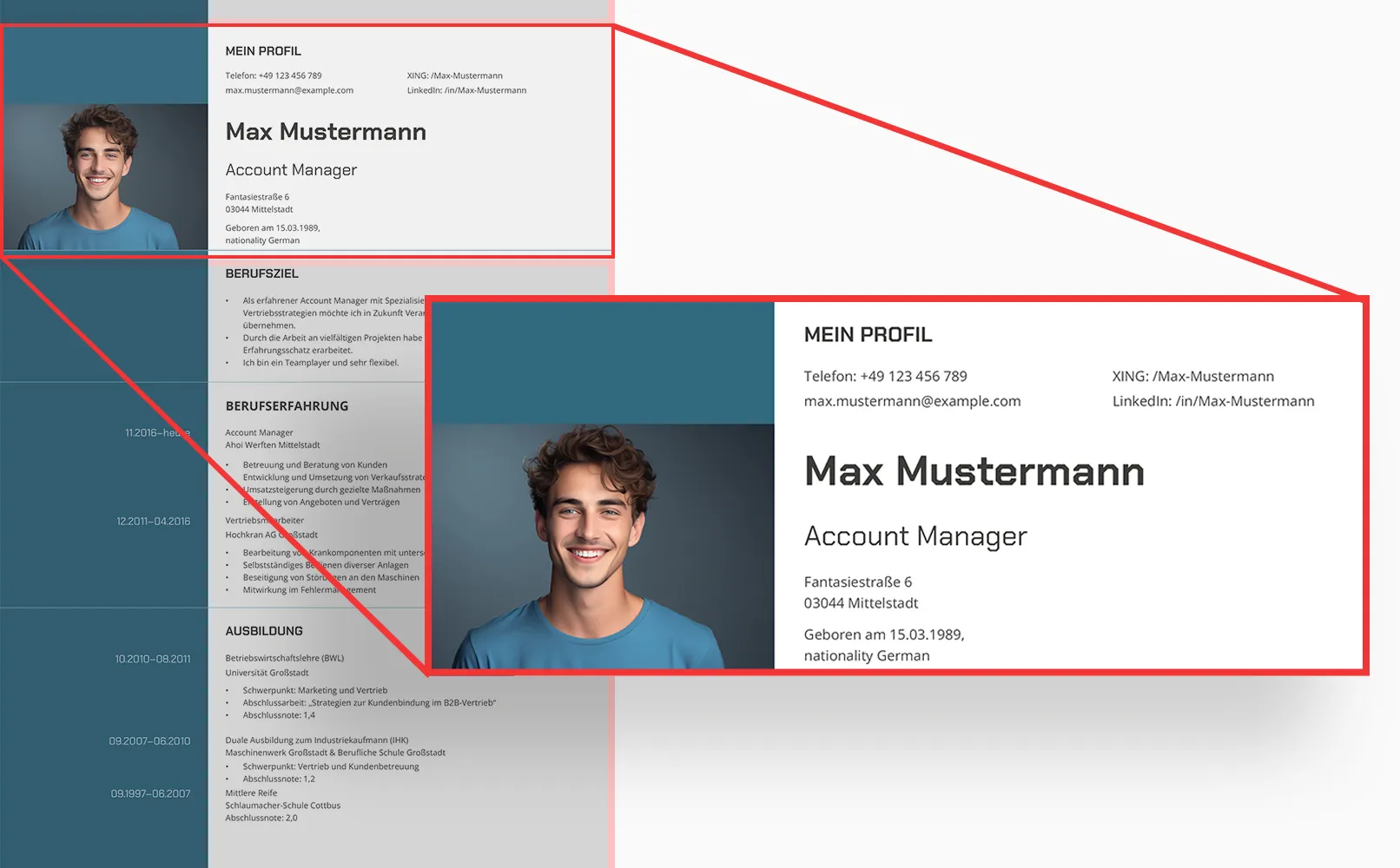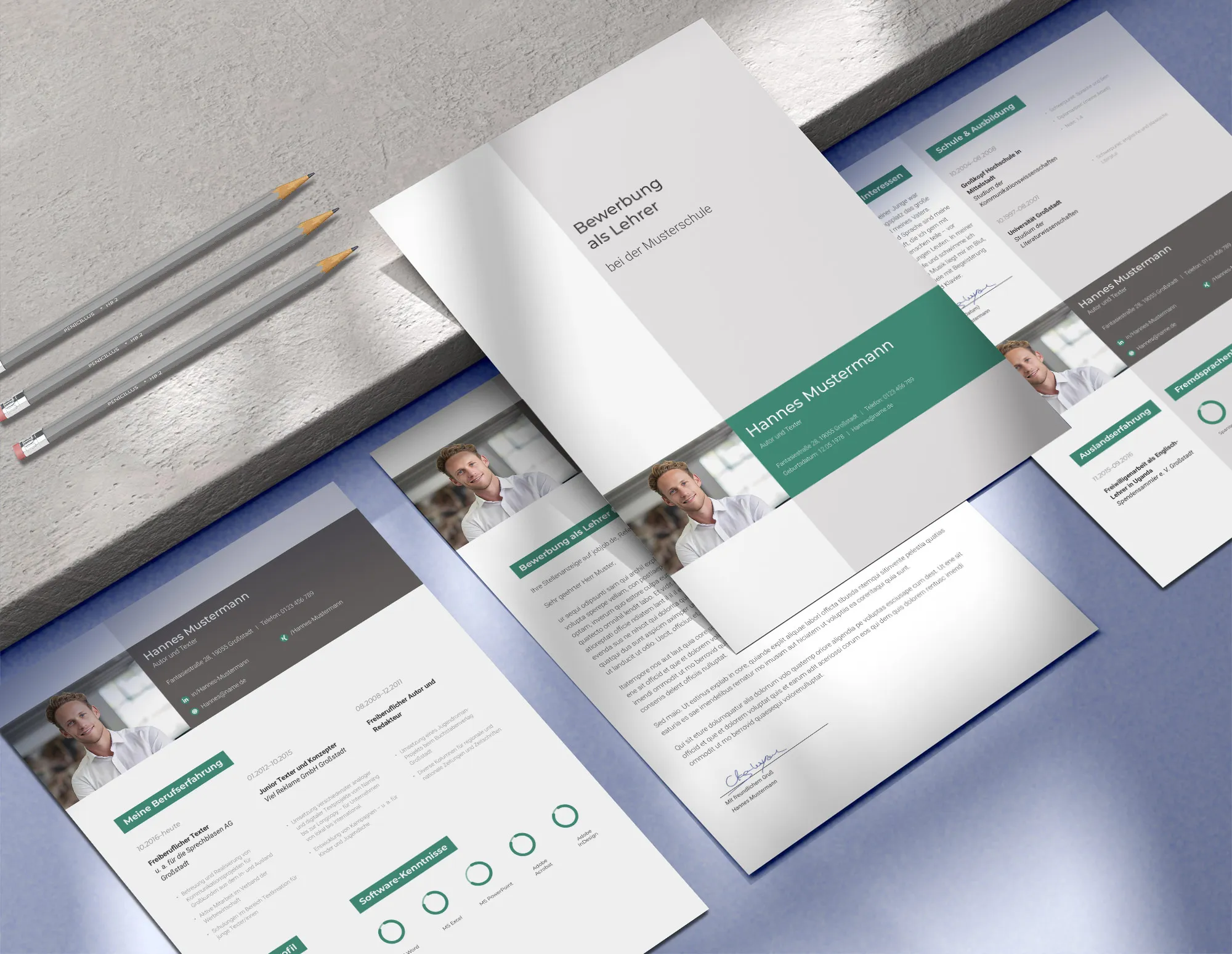The section Personal Data in the CV is the first thing an employer sees when they pick it up or open the file. If you want to make a good first impression, this section must be flawless. There is no room for mistakes, inaccuracies, or unnecessary information here. Your task is to present the most important data clearly and concisely so that the employer can quickly identify you and contact you if needed. If you cannot provide the basic information correctly, what does that say about your professional skills?

In this article, we will discuss which data must be included in this section of your CV, why they are important, how to add them correctly, and which common mistakes you should avoid. Are you ready to make your CV flawless? Then let's get started!
This article is one of several that deal with building a CV. Follow the link to learn more about the structure, examples for filling out, and common mistakes in a CV.
Required Information for the "Personal Data" Section in the CV
In Germany, it is common for every CV to start with the Personal Data section. If you do not fill out this section correctly, your CV simply will not be taken seriously. Basic information about you should be included here, and it must be as accurate and clear as possible. Errors or missing important data can make it harder for you to reach the desired position.

Here is what must be included in the "Personal Data" section and why:
- Photograph: A photo in the CV is still a standard in the German job market for many companies to leave a positive first impression. Although the General Equal Treatment Act (AGG) prohibits discrimination based on appearance, a professional photo remains very important. It shows your seriousness and readiness to work, makes your CV more personal and memorable. A missing or poor-quality photo can raise doubts about your professionalism and attention to detail. If the job posting does not explicitly mention forgoing a photo, add one!
- Name: This is the first thing the employer sees in your CV. If you do not provide your full name, how can you be identified at all? This is a basic requirement without which your CV makes no sense.
- Date of Birth: The employer needs to know your age group to understand if you meet their requirements. This is also important for legal aspects and possible adjustments to working conditions.
- Residential Address: Without a residential address, the employer cannot understand where you are located. This is important for hiring decisions, especially if the work requires physical presence or if the company is looking for candidates from a specific region. It is also important for sending work correspondence.
- Contact Information: You must provide a current phone number and email address. If the employer cannot contact you, you lose the chance to even make it past the initial selection round. Make sure these details are always up to date.
- Nationality: Information on nationality is particularly important if the job requires a specific legal status. The absence of this information may raise questions and doubts at the employer about your ability to work in Germany.
- Marital Status (optional): This point may be useful for some employers to assess your social situation. However, only add it if you deem it necessary and it is truly relevant to the position.
Above, you see a selection of modern CVs. If you are unsure about the difference between a modern and a classic CV, follow the link. In this article, we explain the differences and which one is more suitable depending on the job offer.
Remember that the above-mentioned data forms the basis of your CV. Without them, the employer cannot make an informed decision. Ensure that all information is accurate and up to date so that your CV makes a good impression from the start.
Requirements for the Photo in the CV
The photo in your CV is more than just a formality. It often leaves the first impression on the employer, and you cannot afford any mistakes in its creation. Avoid selfies and amateur shots. Consult a professional photographer. A professional photo demonstrates your seriousness in job search. Follow the recommendations below to get a successful photo and not jeopardize your chances, even if your skills perfectly match the position:
- Smile naturally: Your smile should be friendly, but not too wide. You should convey the impression of being an open and sympathetic person. Only C-level executives can afford not to smile, i.e. people applying for top management positions.
- Keep your head straight: Do not tilt your head, keep it straight. This will make you appear more confident and professional.
- Maintain eye contact with the camera: Look directly into the lens. This gives the impression of self-assurance and honesty.
- Use a neutral background: Forget about colorful or distracting backgrounds or photo backdrops. A neutral, bright background emphasizes your personality without unnecessary details.
- Dress professionally: Choose business attire. For men, a shirt and depending on the industry, a suit jacket, for women a blouse or blazer. Avoid casual clothing.
- Keep a simple hairstyle: Your hairstyle should be neat and not too flashy. Remember, this is not the place to experiment with your appearance.
- Avoid excessive makeup: If you use makeup, it should be natural and subtle. You should look well-groomed, but not intrusive.
- Sit or stand up straight: Your posture should be upright and confident. This conveys professionalism and the impression of reliability.
Most photo shoots are a beautiful dress, a natural location, and poses.
Jenna Dewan
By following these recommendations, you can create a professional photo that highlights your seriousness and readiness to work. Do not leave anything to chance – invest in your first impression!
Common Mistakes
When an employer sees your photo, they begin to form an opinion of you even before reading your resume. So before you start creating your photo, make a list of taboos:
Every photo you take communicates something about a moment in time - a brief slice of time of where you were, who you were with, and what you were doing.
Kevin Systrom
- Avoid photos that look like amateur shots. This appears unprofessional and sloppy.
- Avoid photos of beaches, parties, or other locations with many details. Such environments distract from your person and look very unprofessional.
- Do not draw attention to your appearance. Avoid extravagant hairstyles and flashy makeup. This is inappropriate and detracts from your professional qualities.
- Blurred and pixelated photos are a no-go. They show that you are not willing to invest in your professional presentation.
- Avoid informal poses. Forget relaxed postures, head tilts, or body leans. Your posture should be straight and confident.
- Avoid everyday or sportswear. T-shirts with prints, jeans, and tracksuits are taboo.
- Avoid old photos. Use only current pictures. Old photos may not reflect your current appearance and give a wrong impression.
Remember, a professional photo ensures your first impression. Do not skimp on thorough preparation when creating the photo. If you choose not to include a photo, the recruiter may search for you on Google and social media. Would they like what they find? Your application photo secures the first impression.

Preparing for the Job Interview
After sending your application to the employer, you should prepare for the job interview. There is no job interview where you won't be asked about your strengths and weaknesses. Follow the link and be prepared for any question that comes your way!
How to Properly Add Personal Data to Your Resume
Filling out the section Personal Data in your Resume must be flawless. No uncertainties, no errors. Use clear headings and subheadings for each point. Name, date of birth, address, contact details – everything should be labeled separately and clearly. The employer should be able to find the necessary information immediately. No confusion or prolonged searching.
Stick to a consistent style. Use a professional font like Roboto, Lato, or Montserrat. Avoid Arial, Calibri, or Times New Roman. These fonts are too generic, as you are unique and deserve better fonts that emphasize your professionalism. The font size should be readable, typically 11-12 point. Alignment, spacing, and line heights should be consistent. A professional layout showcases your organizational skills and serious attention to detail.
Make sure all data is current and correct. No old addresses or phone numbers that you no longer use. Regularly check your resume for updates. Incorrect or outdated data is a red flag that could cost you the job. Only provide contact information that you regularly check. It doesn't make sense to provide an email address that you don't open for weeks, or a phone number that is always turned off. The employer must be able to easily contact you, otherwise you may lose the opportunity in the first round of selection.
Conclusion
Filling out the "Personal Information" section in your resume is a test of your attention to detail and professionalism. It is important that every detail is precise, up-to-date, and meets the employer's requirements. Incorrect or incomplete information could cost you the job opportunity. Avoid such mistakes.
Don't want to risk your career because of small mistakes? Download ready-made application templates from TutKit.com. They are designed to ensure flawless design and structure of your resume. Professionals have already done the work for you, so use their experience to increase your chances of success. Download them now and make a professional impression from the start!
Personal data in the resume: The first thing an employer sees
From Vitalii Shynakov
